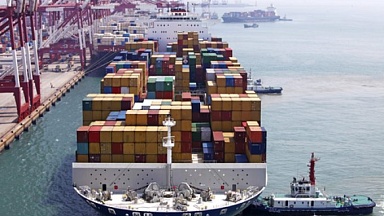In 2023, global maritime trade grew by 2.4% to 12.3 billion tons, rebounding from the 2022 contraction. The sector is projected to grow by 2% in 2024 and an average of 2.4% annually through 2029.
However, soaring freight costs and an «exceptionally daunting operating landscape» driven by geopolitical conflicts and climate risks continue to weigh on a lasting maritime trade recovery.
Demand for iron ore, coal and grains remains strong, while the container trade — up just 0.3% in 2023 — is expected to rebound by 3.5% in 2024, contingent on supply chain stabilization.
A record of almost 250,000 port calls by container ships in the second half of 2023 were driven by growing trade and longer routes, causing some congestion, especially in Asia, which handles 63% of global container trade.
Ton-miles increased by 4.2% due to longer shipping distances from disruptions in key routes like the Suez and Panama Canals, further straining supply chains and adding to greenhouse gas emissions from shipping.
Concerns are growing about a rise in fraudulent ship registrations and registries undermining safety, security, pollution control and seafarer welfare. Ongoing efforts by the International Maritime Organization (IMO) to tackle fraudulent ship registration underscore the urgency of addressing this issue.
Food security, energy supplies and the global economy are at risk as key chokepoints like the Suez and Panama Canals and the Red Sea face growing pressure from geopolitical tensions and climate change.
By mid-2024, Suez transits fell further, with ship capacity (tonnage) crossing the Gulf of Aden down 76% and tonnage transiting the Suez Canal cut by 70%. Cape of Good Hope arrivals surged 89%. Longer routes raised global vessel ton-mile demand by 3% and container ship demand by 12%.
Longer routes have increased costs for fuel, wages, insurance and chartering while boosting emissions. For a 20,000-24,000 TEU vessel on the Far East-Europe route, CO2 emissions alone add $400,000 in costs under the European Union’s Emissions Trading System.
Regional examples show the wider impact. East African nations like Djibouti and Sudan, reliant on the Suez Canal for a third of their trade, face severe disruptions. The Panama Canal disruption has increased sailing distances by 31% for affected routes.
Freight rates surged in 2024 due to rerouting, port congestion and rising operational costs.
By mid-2024, the Shanghai Containerized Freight Index (SCFI) had more than doubled from late 2023, driven by longer shipping distances, higher fuel consumption and rising insurance premiums.
This surge in freight rates, if sustained, will push global consumer prices up, with UN Trade and Development projecting a 0.6% increase by 2025 due to higher shipping costs.
UNCTAD. 2024. «Review of Maritime Transport 2024.» UNCTAD. October 22, 2024. https://unctad.org/publication/review-maritime-transport-2024.




